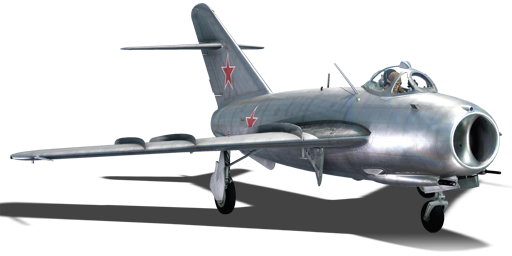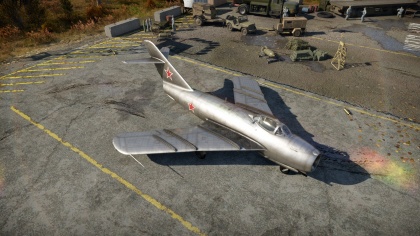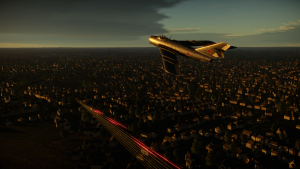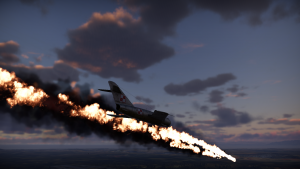Difference between revisions of "MiG-17"
Colok76286 (talk | contribs) (→Media: Added video) |
Colok76286 (talk | contribs) (→Media: Corrected typo) |
||
| Line 229: | Line 229: | ||
;Videos | ;Videos | ||
| − | {{Youtube-gallery|OM1wefnHzYM|'''Using The {{PAGENAME}} To Absolutely Dominate!''' - ''Spit_flyer''|amZQtFjHAn4|'''The Shooting Range #82''' - ''Tactics & Strategy'' section at 00:28 discusses the use of the {{PAGENAME}} against ground forces.|8W7zbLuhrM4|''' | + | {{Youtube-gallery|OM1wefnHzYM|'''Using The {{PAGENAME}} To Absolutely Dominate!''' - ''Spit_flyer''|amZQtFjHAn4|'''The Shooting Range #82''' - ''Tactics & Strategy'' section at 00:28 discusses the use of the {{PAGENAME}} against ground forces.|8W7zbLuhrM4|'''How to fight the OP {{PAGENAME}}!''' - ''MikeGoesBoom''}} |
== See also == | == See also == | ||
Revision as of 18:37, 23 November 2020
Contents
| This page is about the Russian jet fighter MiG-17. For other versions, see MiG-17 (Family). |
Description
The MiG-17 is a rank VI Soviet jet fighter
with a battle rating of 9.0 (AB/SB) and 8.7 (RB). It was introduced in Update 1.55 "Royal Armour". It is known by many names in the world, with a NATO reporting name of Fresco, the Chinese name Shenyang J-5 (歼-5), and the Polish name PZL-Mielec Lim-5.
General info
Flight performance
The MiG-17 can best be described as a more user-friendly MiG-15bis. It features a much better roll rate, compresses less at subsonic speeds, and pulls harder, yet has worse acceleration and energy retention, as well as low speed performance, as well as being easier to rip. It is also the lowest battle rated Soviet plane to be able to breach Mach rated speeds under normal combat conditions.
| Characteristics | Max Speed (km/h at 2,000 m) |
Max altitude (metres) |
Turn time (seconds) |
Rate of climb (metres/second) |
Take-off run (metres) | |||
|---|---|---|---|---|---|---|---|---|
| AB | RB | AB | RB | AB | RB | |||
| Stock | 1,091 | 1,061 | 15500 | 22.2 | 23.2 | 41.2 | 39.1 | 475 |
| Upgraded | 1,128 | 1,114 | 21.2 | 21.5 | 59.9 | 50.0 | ||
Details
| Features | |||||
|---|---|---|---|---|---|
| Combat flaps | Take-off flaps | Landing flaps | Air brakes | Arrestor gear | Drogue chute |
| X | ✓ | ✓ | ✓ | X | X |
| Limits | ||||||
|---|---|---|---|---|---|---|
| Wings (km/h) | Gear (km/h) | Flaps (km/h) | Max Static G | |||
| Combat | Take-off | Landing | + | - | ||
| 0 | 450 | N/A | 650 | 450 | ~12 | ~5 |
Engine performance
| Engine | Aircraft mass | |||||
|---|---|---|---|---|---|---|
| Engine name | Number | Empty mass | Wing loading (full fuel) | |||
| Klimov VK-1 | 1 | 3,868 kg | 223 kg/m2 | |||
| Engine characteristics | Mass with fuel (no weapons load) | Max Takeoff Weight | ||||
| Weight (each) | Type | 9m fuel | 20m fuel | 31m fuel | ||
| 892 kg | Centrifugal-flow turbojet | 4,209 kg | 4,625 kg | 5,041 kg | 5,485 kg | |
| Maximum engine thrust @ 0 m (RB / SB) | Thrust to weight ratio @ 0 m (100%) | |||||
| Condition | 100% | WEP | 9m fuel | 20m fuel | 31m fuel | MTOW |
| Stationary | 2,450 kgf | N/A | 0.58 | 0.53 | 0.49 | 0.45 |
| Optimal | 2,450 kgf (0 km/h) |
N/A | 0.58 | 0.53 | 0.49 | 0.45 |
Survivability and armour
- 60 mm Bulletproof glass in cockpit front.
- 16 mm Steel plates behind the pilot.
- 10 mm Steel plate in the nose.
Armaments
Offensive armament
The MiG-17 is armed with:
- 1 x 37 mm N-37D cannon, nose-mounted (40 rpg)
- 2 x 23 mm NR-23 cannons, nose-mounted (80 rpg = 160 total)
Suspended armament
The MiG-17 can be outfitted with the following ordnance:
- Without load
- 2 x 250 kg OFAB-250-270 bombs (500 kg total)
- 16 x S-5K rockets
- 16 x S-5M rockets
- 2 x S-21 rockets
Usage in battles
Describe the tactics of playing in the aircraft, the features of using aircraft in a team and advice on tactics. Refrain from creating a "guide" - do not impose a single point of view, but instead, give the reader food for thought. Examine the most dangerous enemies and give recommendations on fighting them. If necessary, note the specifics of the game in different modes (AB, RB, SB).
The MiG-17 should be played like its predecessors, the MiG-15s. In 1v1 situations, the -17 will easily win if played correctly, and due to its superior flight characteristics it is easier to win fights against multiple enemies. You have the upper hand in the initial dogfight, as your great turn will allow you to get on their 6 without much difficulty. However, in a prolonged engagement the chances of you losing increase due to your heavier weight and good, yet not spectacular energy retention. If the player is uncomfortable with dogfighting, the MiG-17 can also be a very effective boom-and-zoom fighter.
Modules
| Tier | Flight performance | Survivability | Weaponry | |||
|---|---|---|---|---|---|---|
| I | Fuselage repair | Compressor | Offensive 23 mm | BD-2-48 | ||
| II | New boosters | Airframe | Offensive 37 mm | S5K | ||
| III | Wings repair | New 23 mm cannons | S5M | |||
| IV | G-suit | Engine | Cover | New 37 mm cannons | S21 | |
It is recommended to obtain the modifications in the following order:
Compressor>New boosters>Offensive 37mm>Wings repair>Engine>G-suit>New 37mm cannons>Cover>Offensive 23mm>New 23mm cannons>Airframe>Fuselage repair>Suspended weapons
Pros and cons
Pros:
- Excellent acceleration and speed in dives
- Excellent climb rate and acceleration, almost same as the MiG-15bis
- Guns will tear even the heaviest of bombers into shreds with a good solid burst
- Very good manoeuvrability at low to medium speeds
- More manoeuverable at high speeds than the MiG-15s
- Excellent energy retention, but still loses some speed when turning hard
- If you airbrake enemies should struggle to make you overshoot (but it is risky)
- Performs well at altitude when compared to aircraft such as the F-86F Sabres and the Hunter F.1
- Can safely reach a speed of 1,150 km/h (IAS) and up to Mach 1.10 when diving
- If you do NOT ROLL while you are turning, its hard to break your wings in a turn
- Lack of afterburner makes your fuel not run out insanely fast
- Very similar to the MiG-15bis. This means that the play style between the two is not too different
Cons:
- Roll rate is better than that of the the MiG-15bis, but not on par with others in this tier
- Might lose to a MiG-15bis in low speed turn and acceleration
- Minimal fuel load usually runs out quickly (only eight minutes), forcing to take 20 minutes of fuel
- Guns are hard to aim and lead due to their rather low muzzle velocity
- Guns have small ammo capacity, ammo conservation is a must
- Different trajectories between 23 mm and 37 mm (Vertical Targeting might help with this)
- Mediocre acceleration in speeds between 800 - 1,100 km/h
- Acceleration and energy retention makes defensive fighting harder
- Acceleration and energy retention makes it easier for YOU to overshoot targets
- Does NOT have air-to-air missiles, has no afterburner and has no radar
- Lacks radar rangefinder for the gyro sight
- Engine eventually might overheat when operated over 96% throttle
- Like most jet fighters it does not handle damage very well
History
The Korean war showed that the MiG-15 and MiG-15bis fighters were able to battle any aerial opponent at least on equal terms. The MiG-17 was a further development of the MiG-15 design that had proven itself so well. It was decided to increase the aircraft’s speed by increasing the sweep of the wing and the fuselage being lengthened to maintain the centre of gravity. The MiG-15 and MiG-17 show almost no differences at first glance. The prototype of the MiG-17 was even called the MiG-15bis45. However, only the frontal parts of the fuselage are the same, from the air intake to the wing, if you don’t count the landing headlight that had been moved to the left wing and some minor details.
These aircraft are different in every other way. It is easy to see the main differences when you look from above. By comparing the side profiles, you can see that in addition to the difference in fuselage length there are differences in the tail fin and an additional ventral fin which allows you to immediately tell the MiG-17 apart from the MiG-15. The upper part of the fins and the rudders of the aircraft are different, the juncture between the fin and the stabilizer fin also differs, but this can only be seen close up. The wing sweep of the stabilizer fin was also increased and there were also changes to elevators. The air brakes also differ in shape and size. The depth of the housing was decreased, so a cigar-shaped cowl was created to hide the cylinder. There were very significant changes to the wing. Apart from an increased wing sweep, a leading edge break appeared and the tips became rounder, which helps differentiate the aircraft when looking at them from above or below. While the Mig-15 had two aerodynamic ridges on the top surface of its wings, the MiG-17 had three.
The change in the shape of the wing led to appropriate changes in the construction of the flaps. The new geometry of the main landing gear legs required for the cover to be altered. The structure of the canopy also saw some changes. However, the first versions of the MiG-17 had the same canopies as the MiG-15bis. Apart from changes to the design of the canopy framing (which is not actually that noticeable from afar), a rear-view mirror was introduced that would allow the aircraft to be recognized from further away. There were no significant changes to the cockpit. Overall, the MiG-17 looks even more aesthetically pleasing and streamlined than its predecessor.
Media
- Skins
- Images
- Videos
See also
External links
| Mikoyan-Gurevich Design Bureau (Микоя́н и Гуре́вич Опытное конструкторское бюро) | |
|---|---|
| Fighters | MiG-3-15 · MiG-3-15 (BK) · MiG-3-34 |
| I-225 | |
| Jet fighters | MiG-9 · MiG-9 (l) |
| MiG-15 · MiG-15bis · MiG-15bis ISh | |
| MiG-17 | |
| MiG-19PT | |
| MiG-21F-13 · MiG-21PFM · MiG-21S (R-13-300) · MiG-21SMT · MiG-21bis | |
| MiG-23M · MiG-23ML · MiG-23MLD | |
| MiG-27M · MiG-27K | |
| MiG-29 · MiG-29SMT | |
| Export/Licensed | ␗MiG-9 · ␗MiG-9 (l) |
| ◊MiG-15bis · ◔MiG-15bis · J-2* | |
| MiG-17AS · ◔MiG-17PF · J-4* · Shenyang F-5* | |
| ◊MiG-19S · J-6A* | |
| ◄MiG-21 SPS-K · ◊MiG-21MF · ◔MiG-21MF · ▄MiG-21bis · ◔MiG-21bis-SAU · ◊MiG-21bis-SAU · ◊MiG-21 "Lazur-M" · ▄MiG-21 Bison · J-7II** | |
| ◊MiG-23BN · ◊MiG-23MF · ◔MiG-23MF · ◊MiG-23MLA | |
| ◔MiG-29 · ◊MiG-29 · ◄MiG-29G | |
| *Licensed and domesticated with Chinese designations. | |
| **Unlicensed, reverse-engineered and domesticated with Chinese designations. | |
| See Also | Shenyang · Chengdu |
| USSR jet aircraft | |
|---|---|
| Bereznyak-Isayev | BI |
| Yakovlev | Yak-15 · Yak-15P · Yak-17 · Yak-23 · Yak-28B · Yak-30D · Yak-38 · Yak-38M · Yak-141 |
| Mikoyan-Gurevich | MiG-9 · MiG-9 (l) · MiG-15 · MiG-15bis · MiG-15bis ISh · MiG-17 · MiG-17AS · MiG-19PT |
| MiG-21F-13 · MiG-21PFM · MiG-21S (R-13-300) · MiG-21SMT · MiG-21bis | |
| MiG-23M · MiG-23ML · MiG-23MLD · MiG-27M · MiG-27K | |
| MiG-29 · MiG-29SMT | |
| Lavochkin | La-174 · La-15 · La-200 |
| Sukhoi | Su-9 · Su-11 |
| Su-7B · Su-7BKL · Su-7BMK · Su-17M2 · Su-17M4 · Su-22M3 | |
| Su-24M | |
| Su-25 · Su-25BM · Su-25K · Su-25T · Su-25SM3 · Su-39 | |
| Su-27 · Su-27SM | |
| Su-34 | |
| Ilyushin | IL-28 · IL-28Sh |
| Tupolev | Tu-14T |







